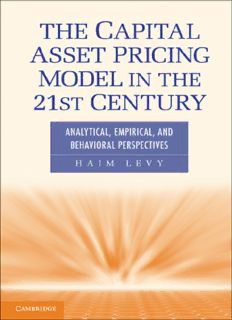
The Capital Asset Pricing Model in the 21st Century: Analytical, Empirical, and Behavioral Perspectives PDF
Preview The Capital Asset Pricing Model in the 21st Century: Analytical, Empirical, and Behavioral Perspectives
TheCapitalAssetPricingModelinthe21stCentury Analytical,Empirical,andBehavioralPerspectives TheCapitalAssetPricingModel(CAPM)andthemean-variance(M-V) rule,whicharebasedonclassicexpectedutilitytheory(EUT),havebeen heavilycriticizedtheoreticallyandempirically.Theadventofbehavioral economics,prospecttheory,andotherpsychology-mindedapproachesin finance challenges the rational investor model from which CAPM and M-Vderive.HaimLevyarguesthatthetensionbetweentheclassicfinan- cialmodelsandbehavioraleconomicsapproachesismoreapparentthan real. This book aims to relax the tension between the two paradigms. Specifically, Professor Levy shows that although behavioral economics contradicts aspects of EUT, CAPM and M-V are intact in both EUT and Cumulative Prospect Theory (CPT) frameworks. There is, further- more,noevidencetorejectCAPMempiricallywhenex-anteparameters areemployed.ProfessionalsmaythuscomfortablyteachanduseCAPM andbehavioraleconomicsorCPTascoexistingparadigms. Haim Levy is Miles Robinson Professor of Business Administration at the Hebrew University of Jerusalem and Dean of the Academic Center of Law and Business, Israel. He is the author of hundreds of articles in leadingacademicjournalsandnineteenbooks.Basedonpublicationsin sixteencorejournalsinfinance,hehasobtainedtherankingofthemost prolificresearcherinfinancecoveringthefifty-yearperiodthrough2002. AcoauthorwithNobelLaureatesHarryMarkowitzandPaulSamuelson, Professor Levy’s major research contributions have been in the field of stochasticdominanceinfinancialeconomics,whichsetsforththecriteria for decision making under conditions of uncertainty. He has also devel- oped economic models for risk management. Professor Levy received Hebrew University’s Prize for Excellence in Research in 1996 and the EMET Prize in 2006. He has served as economic adviser to the Bank of Israel and has held academic positions at the University of Califor- nia, Berkeley, and the Wharton School, University of Pennsylvania. He received his Ph.D. from Hebrew University in 1969 and has held a full professorshiptheresince1976. The Capital Asset Pricing Model in the 21st Century Analytical, Empirical, and Behavioral Perspectives HAIM LEVY HebrewUniversity,Jerusalem cambridgeuniversitypress Cambridge,NewYork,Melbourne,Madrid,CapeTown, Singapore,Sa˜oPaulo,Delhi,Tokyo,MexicoCity CambridgeUniversityPress 32AvenueoftheAmericas,NewYork,NY10013-2473,USA www.cambridge.org Informationonthistitle:www.cambridge.org/9780521186513 (cid:2)C HaimLevy2012 Thispublicationisincopyright.Subjecttostatutoryexception andtotheprovisionsofrelevantcollectivelicensingagreements, noreproductionofanypartmaytakeplacewithoutthewritten permissionofCambridgeUniversityPress. Firstpublished2012 PrintedintheUnitedStatesofAmerica AcatalogrecordforthispublicationisavailablefromtheBritishLibrary. LibraryofCongressCataloginginPublicationdata Levy,Haim. Thecapitalassetpricingmodelinthe21stcentury:analytical,empirical, andbehavioralperspectives/HaimLevy. p. cm. Includesbibliographicalreferencesandindex. ISBN978-1-107-00671-3–ISBN978-0-521-18651-3(pbk.) 1.Capitalassetpricingmodel. I.Title. HG4636.L48 2012 332(cid:3).0414–dc22 2011015049 ISBN978-1-107-00671-3Hardback ISBN978-0-521-18651-3Paperback CambridgeUniversityPresshasnoresponsibilityforthepersistenceoraccuracy ofURLsforexternalorthird-partyInternetWebsitesreferredtointhis publicationanddoesnotguaranteethatanycontentonsuchWebsitesis, orwillremain,accurateorappropriate. Contents Preface pagexi 1 Introduction 1 1.1. TheMean-VarianceRuleandtheCapitalAsset PricingModel:Overview 1 1.2. TheIntensiveUseoftheMean-Varianceandthe CapitalAssetPricingModelamongPractitioners 7 1.3. TheRoleoftheMean-VarianceandtheCapital AssetPricingModelinAcademia 18 1.4. Summary 21 2 ExpectedUtilityTheory 23 2.1. Introduction 23 2.2. TheAxiomsandExpectedUtilityTheory 25 a) TheAxioms 25 b) TheExpectedUtilityPrinciple 28 2.3. IsU(A)aProbabilityoraUtility? 30 2.4. VariousAttitudestowardRisk 31 2.5. PreferencewithRiskAversionandRiskSeeking 37 2.6. CriticismsoftheExpectedUtilityTheory 38 a) AllaisParadox 39 b) CriticismoftheCommonlyEmployedUtility Functions 40 c) CumulativeProspectTheory:Experimental FindingsthatContradictExpectedUtilityTheory 42 d) Roy’sSafety-FirstRule 44 2.7. Summary 44 3 ExpectedUtilityandInvestmentDecisionRules 46 3.1. Introduction 46 3.2. StochasticDominanceRules 47 v vi Contents a) ExpectedUtilityandtheCumulativeDistributions 47 b) TheFirst-DegreeStochasticDominanceDecision Rule 51 c) TheSecond-DegreeStochasticDominance DecisionRule 52 d) TheProspectStochasticDominanceDecisionRule 53 e) TheMarkowitzStochasticDominanceDecision Rule 54 3.3. GraphicalIllustrationsoftheStochasticDominance Criteria 54 3.4. StochasticDominanceRulesandtheDistribution’s MeanandVariance 58 a) Mean,Variance,andStochasticDominanceRules 58 b) Mean,Variance,andRiskAversion 60 3.5. Summary 61 4 TheMean-VarianceRule(M-VRule) 63 4.1. Introduction 63 4.2. TheMean-VarianceRule:PartialOrdering 65 4.3. ExpectedUtilityandDistribution’sMoments: TheGeneralCase 68 4.4. TheQuadraticUtilityFunctionandthe Mean-VarianceRule 72 4.5. QuadraticUtility:AreThereSharperRulesThanthe Mean-VarianceRule? 76 Discussion 79 4.6. NormalDistributionsandtheMean-VarianceRule 85 Discussion 91 4.7. TheMean-VarianceRuleasanApproximationto ExpectedUtility 93 a) TheVariousMean-VarianceQuadratic Approximations 93 b) Discussion:Mean-VarianceApproximationand Mean-VarianceEfficientProspects 100 c) AGeneralUtilityFunctionwithNoDARA Assumption 101 d) ARisk-AverseUtilityFunctionwithDARA 105 e) TheQualityoftheApproximation 108 4.8. Summary 114 5 TheCapitalAssetPricingModel 117 5.1. Introduction 117 5.2. TheMean-VarianceEfficientFrontier 120 a) TheMean-VarianceFrontierwithOneRiskyAsset andOneRisklessAsset 120 Contents vii b) TheMean-VarianceFrontierwithn-RiskyAssets 123 c) TheMean-VarianceFrontierwithn-RiskyAssets andtheRisklessAsset 128 5.3. TheDerivationoftheCapitalAssetPricingModel 134 a) Sharpe’sCapitalAssetPricingModelDerivation 135 b) Lintner’sCapitalAssetPricingModelDerivation 139 c) Discussion 143 5.4. EquilibriumintheStockMarket 149 5.5. Summary 154 6 ExtensionsoftheCapitalAssetPricingModel 156 6.1. Introduction 156 6.2. TheZeroBetaModel 158 6.3. TheSegmentedCapitalAssetPricingModel 164 6.4. Merton’sIntertemporalCapitalAsset PricingModel 168 6.5. TheHeterogeneousBeliefsCapital AssetPricingModel 171 6.6. TheConditionalCapitalAssetPricingModel 175 6.7. Ross’sArbitragePricingTheory 179 6.8. Summary 184 7 TheCapitalAssetPricingModelCannotBeRejected: EmpiricalandExperimentalEvidence 186 7.1. Introduction 186 7.2. TheEarlyTestsoftheCapitalAssetPricingModel: PartialSupportfortheCAPM 191 (i) TheFirst-PassRegression(Time-Series Regression) 191 (ii)TheSecond-PassRegression(Cross-Section Regression) 191 a) TheStudybyLintner 192 b) TheStudybyMillerandScholes 195 c) TheStudybyBlack,Jensen,andScholes 196 d) TheStudybyFamaandMacBeth 199 e) TheRoleofBetaandtheVarianceasExplanatory Variables 200 7.3. TheSecondCycleofTests:MainlyRejection oftheCAPM 202 a) TheSmallFirmEffect 203 b) TheThree-FactorModelofFamaandFrench 205 c) TheStudyofGibbons,Ross,andShanken:A MultivariateTestofAlphas 207 7.4. Roll’sCritiqueoftheEmpiricalTests 209 viii Contents 7.5. ShortPositionsEverywhereontheFrontier: AllegedlyProvidesEvidenceagainsttheCapital AssetPricingModel 212 7.6. TheCapitalAssetPricingModelCannotBeRejected onEmpiricalGroundAfterAll 214 a) ConfidenceIntervaloftheβ Approach 215 b) APositivePortfolioExistswithEx-AnteMeans 219 c) ReverseEngineering:TheApproach ofM.LevyandR.Roll 221 d) TheSmallFirmEffectandtheInvestmentHorizon 224 7.7. ExperimentalStudiesoftheCapital AssetPricingMarket 233 7.8. Summary 237 8 TheoreticalandEmpiricalCriticismof theMean-VarianceRule 239 8.1. Introduction 239 8.2. DistributionofReturns:TheoreticalApproach 242 8.3. TheEmpiricalDistributionofReturn:TheParetian VersustheNormalDistribution 249 8.4. AHorseRacebetweenVariousRelevant Distributions:TheCharacteristicsoftheVarious DistributionsandtheMethodology 255 8.5. ShortInvestmentHorizonandtheLogistic Distribution 261 a) TheEmpiricalResultfortheRelativelyShort Horizon 262 b) TheHorizonEffectonVariousParameters 265 c) TheLogisticDistribution:TheM-VRuleIs Optimal 270 8.6. GoodnessofFit:InvestmentHorizonLonger ThanOneYear 275 8.7. EmployingtheMean-VarianceRule: TheEconomicLoss 280 8.8. NormalDistribution:IsMarkowitz’s EfficientSetTooBig? 286 8.9. Summary 296 9 ProspectTheoryandExpectedUtility 299 9.1. Introduction 299 9.2. ProspectTheoryandExpectedUtility 303 a) ProspectTheoryandExpectedUtility Maximization 304 b) AssetIntegration 308 c) RiskAversion 311 Contents ix 9.3. TheValueFunction 316 a) TheShapeoftheValueFunction 316 b) LossAversion 317 9.4. TheDecisionWeightFunction 323 9.5. TheProsandConsofProspectTheory DecisionWeights 327 a) Drawback:First-DegreeStochasticDominance Violation 327 b) SomeAdvantages 329 9.6. Summary 330 10 CumulativeDecisionWeights:NoDominanceViolation 333 10.1. Introduction 333 10.2. Rank-DependentExpectedUtility 336 10.3. CumulativeProspectTheoryDecisionWeights 340 10.4. TheValueandtheDecisionWeightFunctionsas SuggestedbyCumulativeProspectTheory 345 10.5. TheVariousDecisionWeights: FormulasandEstimates 347 a) LeftTailIrrelevance 353 b) CumulativeProspectTheory’sUnreasonable DecisionWeights:TheEquallyLikely OutcomeCase 354 c) IrrelevancyoftheAlternativeProspects 356 10.6. TheSuggestedProspect-DependentDecision WeightsModel 357 10.7. First-DegreeStochasticDominanceViolations DuetoBoundedRationality 366 10.8. Summary 370 11 TheMean-VarianceRule,theCapitalAssetPricingModel, andtheCumulativeProspectTheory:Coexistence 372 11.1. Introduction 372 11.2. GainsandLossesVersusTotalWealth 374 a) TheWealthEffectontheMean-Variance EfficientFrontier 375 b) TheWealthEffectontheCapitalAsset PricingModel 378 11.3. RiskAversionVersustheS-ShapeValueFunction 380 a) DiversificationIsNotAllowed 380 b) DiversificationbetweenRiskyAssetsIsAllowed 383 c) DiversificationIsAllowedandaRiskless AssetExists 390
Description: